Description
The bourgeois terraced house, Brussels’ dominant housing type as documented in the text Brussels as a City of Row Houses: From the Origins to 1914, is not the city’s only residential form. However, its importance in terms of numbers as well as in the city’s collective unconscious has made it a benchmark against which to compare all other housing forms in the territory, including those that existed before. Comparing other residential forms with the standard form of housing allows us to understand why and how they appeared on the Brussels territory, both before and after the golden age of the Brussels terraced house at the turn of the 20th century. Hence, this chapter aims to offer a genealogy of such residential forms, organised according to spatial and typological features rather than chronologically. While some resemble the dominant – referential – type, others diverge partially or completely from it.
Continuing the Terraced House
Two of these other forms of housing are directly related to the referential type: palaces consisting of multiple houses and houses built over a sunken garage.
Palace of Houses
The earliest forms of social housing are consistent with the dominant type, producing only minor variations on its four basic spatial features yet often complementing them and producing a collective effect that goes beyond the individual house. The Cité Fontainas from 1867 by Antoine Trappeniers and Henri Beyaert, next to the Porte de Hal, reflects this desire to create a unified setting for a group of modest dwellings: the façade of a palace conceals a series of 16 terraced houses.[1] Similar to Partoes’ classical beguinage or English crescents, the building thus gives the illusion of living in a palace, which corresponds to the bourgeois image of the city.
Replacing Servants’ Quarters in the Basement with Garages
At the end of the First World War, two changes had a direct impact on housing in Brussels. From a social point of view, home-based domestic servants were disappearing. From a technical point of view, the widespread use of the car modified people’s relationship with public space as well as with individual housing, which now required garages. These changes did not dramatically modify the standard housing type: garages replaced the servants’ spaces in the sunken basement. Houses were set back from the street to allow access ramps for automobiles. In addition, with the disappearance of domestic servants, the kitchen migrated to an annex on the bel étage, where it had been in the Leopoldian House, the 19th century design scheme.
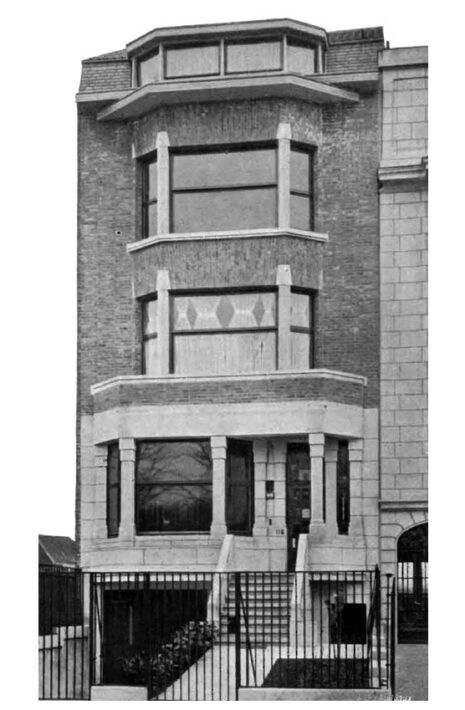 After the First World War, houses were set back from the street to allow access to garages set in sunken basements (De Ridder, boulevard Saint-Michel 97, 1923).
After the First World War, houses were set back from the street to allow access to garages set in sunken basements (De Ridder, boulevard Saint-Michel 97, 1923).
These houses were built largely in the city’s second belt, primarily in the east (Woluwé-St-Pierre, Woluwé-St-Lambert, Auderghem, etc.). They were built on plot widths similar to those used at the end of the 19th century and were likewise organised as closed city blocks. They reproduced the individual character, the limited height, and the repetitive layout of the referential type. In both variations the socio-cultural conventions associated with the bourgeois terraced house were preserved, together with the four spatial characteristics of the traditional type.
Departing from the Terraced House Type
All other forms of housing in Brussels represent a departure from the dominant type of the bourgeois terraced house, the bonne maison moyenne, and can be characterised by these deviations from Brussels’s dominant type. Looking at them through this lens generates a new typology based on spatial composition rather than chronology.
(Sub)Urban Villas
Just as terraced buildings were built in the centre during the 19th-century expansion, free-standing villas were chiefly built on the outskirts of the city. Until the early 20th century, municipalities such as Uccle or Laeken were located just outside the city. They were trendy weekend getaways featuring destinations such as the Chalet Robinson, the Chalet du Laerbeek, etc.,[2] and also became very popular locations for secondary residences and villas for the wealthy. King Leopold II himself set the tone by adding two wings to the Castle of Laeken, which supplemented the royal palace in the city centre.
Those houses deviated from the pattern of closed urban blocks, and were usually free-standing on large plots of land. The garden was no longer residual, but rather designed in its own right as a park with expensive features such as pavilions, pools, and pergolas, for instance at Villa Empain, designed in 1930 by Michel Polak and Alfred Roth. Houses developed forms and volumes unconstrained by party walls, often leading to free and innovative compositions in which the traditional hierarchy of the bourgeois row house was abandoned. This is illustrated by the Villa Bloemenwerf by Henry Van de Velde from 1895. Some of these richly ornamented houses could be considered a Gesamtkunstwerk in which architecture and art merged; an excellent example is The Art Deco mansion of Palais Stoclet by Josef Hoffmann, 1911, with its built-in works by Gustav Klimt and Fernand Khnopff.
From a stylistic point of view, inspiration could be drawn from widely different sources – from the English cottage (albeit with a very modernist layout, as in the Villa Bloemenwerf) to Art Deco (Villa Empain, Palais Stoclet). A recurring feature of these free-standing villas was the double-height hall with an upper gallery leading to the bedrooms. Additional functions were often incorporated in these villas: these could include an atelier (Villa Bloemenwerf); a personal office (Villa Empain); or the complete bourgeois panoply such as a smoking room for the gentlemen, piano room, study, and servants’ quarters (Palais Stoclet). In these villas, while the individual character and the low heights of the dominant type were maintained, there was no longer a connection to closed urban blocks and their layouts were much more innovative, with rooms that fitted their functions.
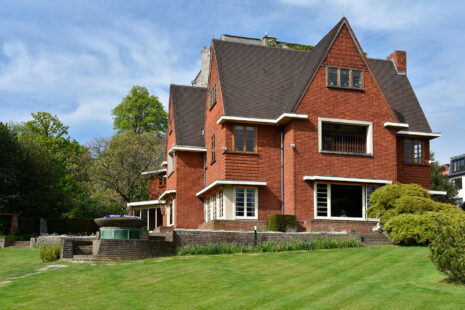 Standing alone in its private park, the Van Buuren Villa is free from terraced housing’s party walls, opening up the urban block (Govaerts-Van Vaerenbergh, 1928).
Standing alone in its private park, the Van Buuren Villa is free from terraced housing’s party walls, opening up the urban block (Govaerts-Van Vaerenbergh, 1928).
Early Collective Public Housing
With the growth of the city in the 19th century, housing the working class became a major issue. Brussels was Belgium’s main industrial city and the ruling class tried to keep the workers under its thumb. The governing bourgeoisie had three major fears: epidemics, social conflicts, and working-class morality. Housing was one of the levers used to address these concerns. Several national congresses[3] recommended breaking with traditional housing formations such as bataillons carrés, dead ends, etc., which could be found in the old parts of town.
Widespread social unrest in 1886 led to the first social-housing law.[4] The law of 9 August 1889 endorsed the single-family house by prioritising access to private property, part of a process by which the bourgeoisie tried to control precarious populations by imposing its own way of living on them. A nuclear-family-centred model was favoured to avoid larger gatherings that could disturb the public order. In the first chapter, we saw that several solutions sought to place workers in homes mimicking bourgeois houses. The desire to isolate working people manifested itself in schemes to house workers in individual houses.
In addition to these single-family dwellings, several collective housing projects were erected reflecting a strong paternalistic approach, using housing as a tool to control workers.[5] Inspired by the work- and lodging-houses of London or the Cite Napoleon in Paris, Cité[6] Pauwels (designed by Félix Pauwels), was one of these projects. Built in 1850 (and demolished already in the 1870s), it was designed for bachelors; they shared a series of services (common kitchen, bathroom, laundry room with hot water, workshop, and library with a reading room) and a garden on the ground floor.[7] On the upper floors, single rooms were organised along a central corridor.
Two decades later, inspired by Charles Fourier, the founder of utopian socialism, Jean-Baptiste Andre Godin built the Familistère, of Laeken, attached to his stove factory on the canal.[8]
As in Guise, where he built his first familistère, Godin produced an autarkic environment bringing together housing, collective amenities, and work. Such paternalist designs were nonetheless exceptions.
At the turn of the century, social-sector collective housing projects conceived to house the working class recalled these earlier, paternalist approaches. The reason was simple: apartment buildings proved more cost-effective and produced a larger number of dwellings than the archetypal individual house. Between 1899 and 1914, the earliest social-housing companies[9] built over 60,000 dwelling units in Belgium.[10] In Brussels, this period saw the construction of the Cité Reine Astrid (1915, Émile Hellemans); Cité de l’Olivier (1905, Henri Jacobs); Cite de la Foret d’Houthulst; Cite Dubrucq; Berkendael; Delva; Osseghem; the apartment buildings Marconi 32 ( 1901, Léon Govaert), and Rodenbach 14–35 (1905, Charles De Quéker and Alphonse Hannaert). In 1919, the Societe Nationale des Habitations et Logements a Bon Marche (SNHLBM) was founded following pressure from left-wing politicians. It promoted the construction by local housing companies of collective and affordable workers’ housing. Its mission was to meet the huge demand for housing following the devastation of the First World War, during which more than 200,000 homes were destroyed in Belgium.
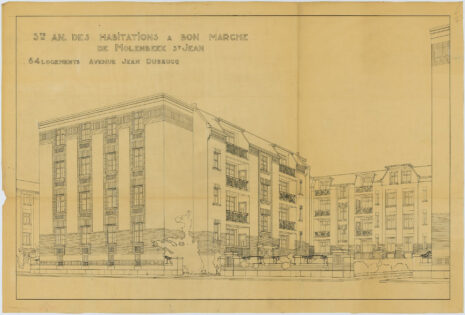 Before the Second World War, social housing gradually became collective while retaining the relatively low height and polyvalence of standard row housing (Adolphe Puissant, Cité Dubrucq, 1924).
Before the Second World War, social housing gradually became collective while retaining the relatively low height and polyvalence of standard row housing (Adolphe Puissant, Cité Dubrucq, 1924).
These pre- and post-war collective public-housing projects shared similar spatial characteristics.[11] Like the dominant terraced-house type, they were limited to four or five floors as lifts were not yet affordable in the social sector. In terms of layout, they share another feature with Brussels’ standard type, namely the inclusion of two kinds of rooms, large and small, that were very flexible in terms of use. In addition to rejecting the dominant type’s individual character, these projects also questioned its connection to closed city blocks and its small plot divisions.
City blocks were opened up and semi-public or entirely public spaces such as courtyards (for instance at Cité de l’Olivier and Cité Melckmans (1932, Fernand Brunfaut), alleyways (recalling the dead-end streets found in medieval city blocks, as in Cité Reine Astrid), or even shortcuts through the block as at Cité Van Hemelrijck (1932, Joseph Diongre) were developed. While admitting more light into the dwellings, these new urban morphologies disrupted the traditional front/rear opposition.
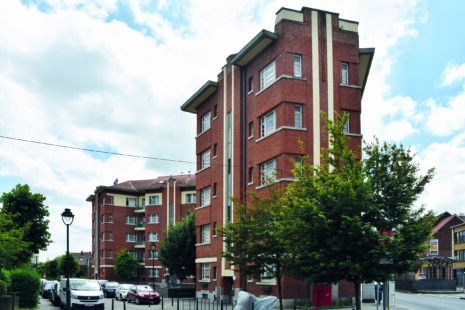 The 60-unit apartment building of Cité Melckmans (1932, Fernand Brunfaut) has a generous courtyard.
The 60-unit apartment building of Cité Melckmans (1932, Fernand Brunfaut) has a generous courtyard.
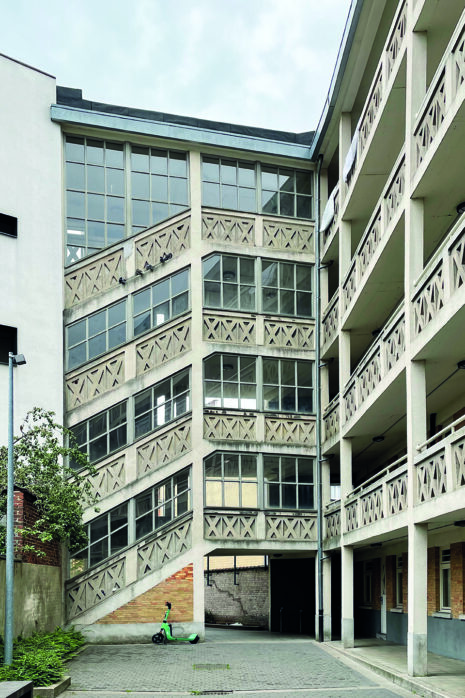 The apartment building Cité Van Hemelrijck (1932, Joseph Diongre) has a 9-m-wide pedestrian walkway connecting two streets across the plot.
The apartment building Cité Van Hemelrijck (1932, Joseph Diongre) has a 9-m-wide pedestrian walkway connecting two streets across the plot.
The Light of Art Nouveau
At the end of a frantic 19th century, the Art Nouveau movement led to another evolution. While often considered a stylistic revolution, in Brussels it was closely associated with a reconsideration of the referential housing type. The use of iron was at the root of this upheaval;[12] its malleability allowed for a new aesthetic language, but also for a substantial lightening of buildings’ load-bearing elements. In combination with glass, which could now be wired, it made possible skylights that revolutionised domestic spaces.
The traditional bourgeois row house consisted of three rooms in a row. The central room of the enfilade was usually dark since it had no direct opening to the outside. Moreover, its central position put it at the crossroads of the floor’s circulation. It was therefore difficult to use, especially as its width was limited by the space taken up by the staircase in the adjoining narrow bay. Art Nouveau architects would transform this layout by creating light wells combined with staircases in the middle of the house, allowing natural light into every room. In that sense, Victor Horta shook up the Brussels’ referential type in a luminous way. In Horta’s late 19th-century housing designs, the dark central room disappears, replaced by a generous skylight that illuminates the entire building. The staircase and the circulation were no longer relegated to a dark corridor, but rather built into this skylit space. The Hôtel Tassel (1894, Victor Horta), in Ixelles (1894), and the Aubecq House (1902), Horta House (1901), and van Eetvelde House (1900), built for Edmond van Eetvelde, the administrator of Congo Free State, are dazzling applications of this central light well. Beyond the new plastic language and the formal research, therefore, the Brussels masters’ stroke of genius lay in overturning the traditional bourgeois terrace-housing type.
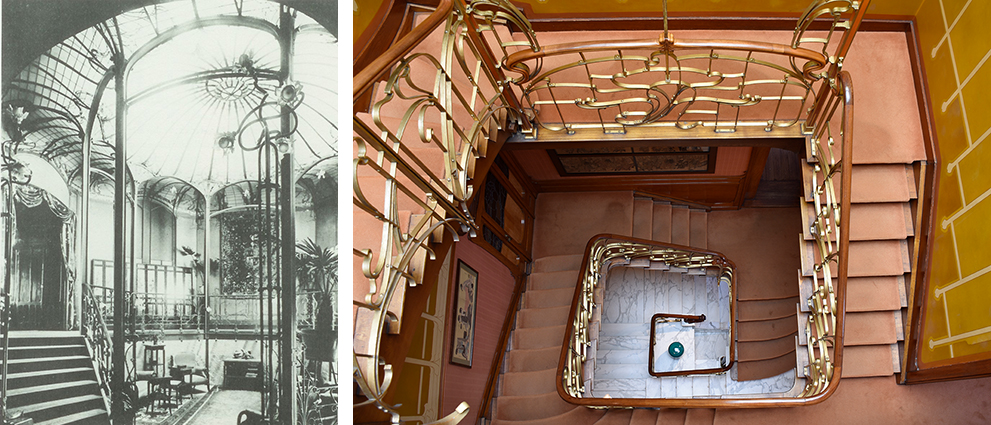 By introducing a light well at the heart of the house, Victor Horta took the opposite approach to standard housing, which was traditionally dark in the centre (van Eetvelde House, 1900; Horta House, 1901).
By introducing a light well at the heart of the house, Victor Horta took the opposite approach to standard housing, which was traditionally dark in the centre (van Eetvelde House, 1900; Horta House, 1901).
Not all Art Nouveau embraced this revolutionary plan, however. Some made few changes to the traditional bourgeois terraced-house plan, making only stylistic adjustments. Paul Hankar’s personal house in Ixelles (1893) was a good example[13] of this tendency.
Nevertheless, Horta and followers such as Gustave Strauven (Maison Strauven, 1902; Maison St Cyr) revolutionised the layout of the standard house. Even if all its other spatial features remain unchanged, central rooms acquired a grander status – thus modifying the interior hierarchy of the dwelling.
Blending City and Nature
At the end of the 19th century, the SABH (Société Anonyme des Habitations Ouvrières, founded in 1868) built two developments inspired by Emile Muller’s carrés mulhousiens (1854). In the carrés mulhousiens, workers were housed in free-standing villas surrounded by gardens. This respectable patrician image was just a simulacrum, however: each villa contained four dwellings.[14] Besides giving worker housing an honourable appearance, the projects located in Cité de Dilbeek (1840), in Molenbeek, and Cité de Linthout (1871) in Schaerbeek were set in a green environment near the city.
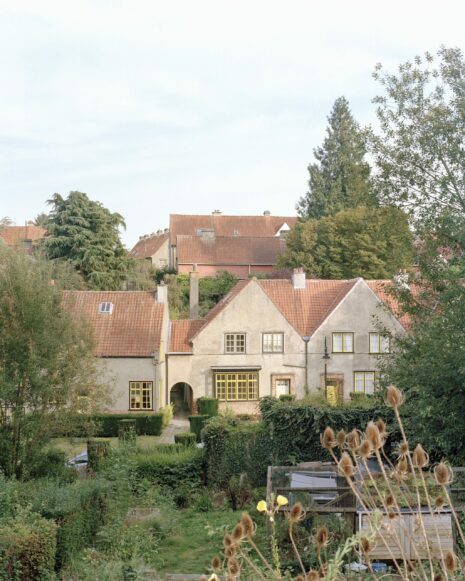 Garden cities blended nature and city, while opening up the traditionally closed urban block: Le Logis-Floréal, Jean-Jules Eggerickx and Louis Van der Swaelmen, 1922.
Garden cities blended nature and city, while opening up the traditionally closed urban block: Le Logis-Floréal, Jean-Jules Eggerickx and Louis Van der Swaelmen, 1922.
The garden-city movement of the 1920s stemmed from the same ambition, with settlements, often organised as cooperatives, built along the city’s green fringes.[15] The first garden cities were inspired by the English movement begun by Ebezener Howard and Raymond Unwin, to whom obvious tribute was paid through a series of stylistic elements (pitched roofs, window divisions and shutters, use of brick and tile, etc.), giving the impression of wandering in an English village, for example at Le Logis-Floréal (1922, Jean-Jules Eggerickx and Louis Van der Swaelmen). Some settlements, on the other hand, were clearly inspired by the modernist movement and the German Siedlungen. Victor Bourgeois’ project for the Cité Moderne (1925) was among the earliest examples of modernist housing, with clear-cut changes in construction such as the use of concrete, flat roofs, etc. The project and its unbuilt extension were exhibited at the second Frankfurt CIAM in 1929. The estate of semi-detached houses Kapelleveld, designed in 1926 by Van der Swaelmen and Huibrecht Hoste in Woluwé-St-Lambert with the contribution of various architects, was another example of this modernist trend. It displayed an entire, self-sufficient neighbourhood with services, shops, and sports facilities on the outskirts of the city. While all these examples emerged from public or cooperative initiatives, the Coghen Square in Uccle was an exception. It was designed as a private development in the late 1920s for the wealthy bourgeoisie. Designed to offer an oasis of greenery in the middle of an urban block, it included the work of several Belgian modernist architects such as Josse Franssen, Louis-Herman De Koninck, or Pierre Verbruggen.
From 1926 onwards, the garden-city movement was considered too costly for the state and too space-consuming. Conservative politicians were also worried about the development of a “socialist ring” around the city. They opposed social rental or cooperative housing, preferring strictly private housing. Although short-lived, garden cities’ dispersed planning and green environments nevertheless had a great effect on Brussels and on people’s imagination. Today, these garden cities can be found almost uniformly around the city, caught up in the urban sprawl of the 20th century.
Both the Mulhouse-based projects and the garden cities maintained three features from the terraced housing type: low-rise housing, individual character, and function-free layouts. One main difference was introduced, however: the opening of city blocks to allow nature to spread within the developments, while reducing dwellers’ visual privacy.
Private Collective Housing
Unlike in many European cities, Brussels’ bourgeoisie did not turn to apartment buildings in the 19th century. On the contrary, the middle and upper classes remained very attached to the independent life enabled by the bourgeois row house. Despite this deeply-rooted attachment to individual housing, early large-scale development was carried out in 1870 on the new central boulevards following the culverting of the Senne River, which had become an open-air sewer. Built by French developers according to a successful Parisian Haussmannian model, the operation was a financial debacle. There were several reasons: as mentioned, apartments did not correspond to the bourgeoisie’s way of life. Additionally, the project was located in the lower part of town – which was traditionally dedicated to trade, industry, and lower-class housing – while the wealthy population occupied the higher ground of the eastern slopes. To make matters worse, the plots on which the apartment buildings were set were less deep than in Paris, preventing the proper implementation of well-lit courtyards.[16] Eventually, the bourgeoisie’s lack of interest in this new development forced the city of Brussels to buy many of the buildings, which it still owns to this day. Other buildings were transformed, as in the case of Place de Brouckère (1876, Gédéon Bordiau), which was annexed by the Metropole Hotel at the beginning of the 20th century.
Until the First World War, private apartment buildings were uncommon, except for some corner-plot constructions or twin houses. The year 1918, however, was a turning point on several levels. Private domestic staff became unaffordable for the common bourgeoisie. Moreover, new technologies – such as lifts, reinforced concrete, pile foundations, steel frames, intercom systems, central heating, running water, etc. – became available, at a time when most standard bourgeois houses were still equipped with coal stoves and no running water.[17] In 1924, a new co-ownership law was passed, enabling the smooth management of collective life in an apartment building.
Consequently, numerous private promoters such as the Societé Belge Immobiliere, the Societé des Pavillons Français (1934, Marcel Peeters), Kaisin pere et fils, Etrimo, etc. began building apartment buildings after the First World War. Among the achievements of the interwar period were two buildings that heralded the changes to come, one displaying an abundance of shared amenities, the other unprecedented heights. On the one hand, the Résidence Palace (1927, Michel Polak), symbolised the interwar bourgeoisie congregating around collective facilities. Built in 1927 for a wealthy clientele on the initiative of Lucien Kaisin, it was both a hotel and a residential project, with 180 apartments. The building complex offered an incredible series of services and amenities of a rare quality: an indoor swimming pool, cinema, theatre, bank, restaurant, hairdressers, shops, garages, fencing and tennis courts, gymnasium, etc. The project was the last of its kind, however, a victim of the 1929 stock-market crash. By 1941, it was uninhabited. After the Second World War, the building lost its residential function; it was bought by the Belgian state to be transformed into offices, and gradually incorporated into the European institutions, for which it now houses the Council and the press centre. On the other hand, the Résidence de la Cambre (1939, Marcel Peeters) offered fewer amenities but took full advantage of new construction techniques. Built in 1937, its 18 floors made it Brussels’ first skyscraper.[18]
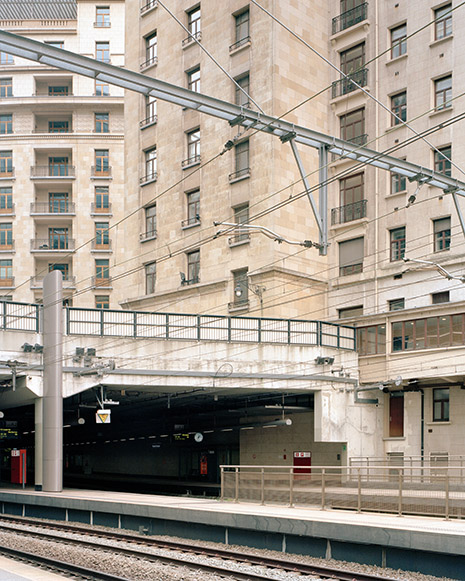 The Résidence Palace (1927, Michel Polak) was both a hotel and a residential building, with 180 apartments. The complex offered many amenities.
The Résidence Palace (1927, Michel Polak) was both a hotel and a residential building, with 180 apartments. The complex offered many amenities.
Collective amenities and greater heights characterised the new apartment buildings built in the private sector between the wars. On the boulevards, avenues, and roundabouts of the city, new apartment buildings were erected (for instance, Palais de la Folle Chanson, 1931, Antoine Courtens); Les Pavillons Français, 1934, Marcel Peeters; Résidence Léopold, 1937, Jean-Jules Eggerickx and Raphaël Verwilghen). These wider roads allowed taller buildings without compromising natural light. Their skyline thus evolved dramatically; the personal interactions made possible by low-rise housing were lost. These buildings conveyed a sense of majesty, with large and ornamented entry halls, facades with three registers (base, shaft, and capital), precious and highly crafted materials, etc. Sometimes, the grandeur was only a mirage: some buildings, such as the twin apartment buildings at Avenue de Broqueville 1–4, 1932, Raymond Burgraeve, were barely more than a facade.
Jean Delhaye, one of Horta’s disciples, published a book on the advantages of apartment living.[19] Just as Louis Cloquet’s book[20] influenced the single-family house in the early 20th century, Delhaye’s had a lasting impact on Brussels housing. Besides collective living and greater building heights, the major change concerned living on a single floor. Delhaye developed a scheme organised around a clear day/night separation for living functions.
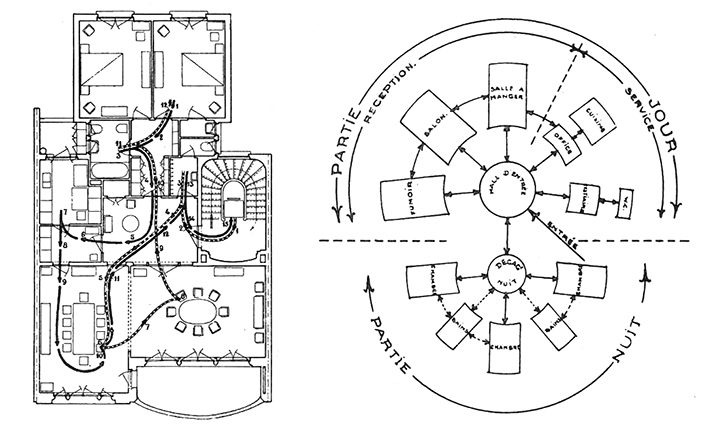 Jean Delhaye’s ideal apartment layout, introducing a clear day/night division in a single-storey space (1946)
Jean Delhaye’s ideal apartment layout, introducing a clear day/night division in a single-storey space (1946)
Private collective buildings diverged in two ways from the referential type of the terraced house. In addition to rejecting individual housing, they were taller. Nevertheless, rooms remained fairly flexible in terms of use and the buildings were still set in closed urban blocks.
The Counterpoint to the Terraced House: Modernism
In Belgium, the influence of modernism developed in two stages. Before the Second World War, a few pioneering architects tried to impose their vision, but their influence was very limited in terms of construction. Massive post-war reconstruction, however, operated with the tools developed by modernism.
Interwar Period
After the First World War, modernist architects strongly believed that architecture could revolutionise human societies.[21] The need for housing was acute and the first three Congrès Internationaux d’Architecture Moderne (CIAM) explicitly addressed this issue. Before the Second World War, modernism was introduced by CIAM’s Belgian members – Victor Bourgeois, Huib Hoste, Louis-Herman De Koninck, Renaat Braem, and Raphael Verwilghen[22] – but also through publications L’Equerre[23] and Opbouwen. The third CIAM, held in Brussels in 1930, was the pinnacle of the modernist movement in Belgium.
Most projects developed at the time were visionary and remained rhetorical,[24] such as Renaat Braem’s linear city between Antwerp and Liege (1934),[25] the 1933 competitions for Antwerp’s east bank, or Jasinski’s administrative city on Brussels’ central boulevards (1930).[26] Victor Bourgeois was one of the leading figures of this movement. He developed two urban schemes for Brussels, which remained unbuilt but were both presented at the 1930 CIAM:[27] Le Nouveau Bruxelles (1930) and Le Grand Bruxelles.[28] Bourgeois defined the city as a territorial phenomenon that went beyond its usual limits and spread out along the canal between its two economic centres to the north and south (Vilvoorde and Clabecq). In Le Nouveau Bruxelles, Bourgeois planned a new neighbourhood north of the city, along the Senne Valley, on the western bank of the canal. Its structure differed from that of the traditional city, and was based on the functional city’s four quadrants: residential, commercial, leisure, and mobility.[29] The 25,000-dwelling development was divided into four residential zones by a large cross-shaped public green zone featuring leisure and community facilities.
Housing was in elongated, ten-storey, free-standing buildings located in green spaces in the immediate vicinity of services such as kindergartens, playgrounds, parking lots, etc. The first two floors were occupied by commercial spaces, while the upper floors were dedicated to dwellings. These were organised in duplexes accessible from a wide central interior corridor on every other floor. Broad terraces off the living spaces allowed light to enter this collective circulation directly. All modern comforts were foreseen: these included well-organised kitchen equipment and bathrooms, but also a supply line for goods. Finally, collective amenities such as gardens, sports facilities, and sun decks were located on the top floor.
These large-scale projects remained theoretical, but modernist architects built a series of smaller projects and individual houses in the modernist garden cities mentioned before such as the Kapelleveld (1926, Van der Swaelmen), but also for private commissions such as the Maison Dotremont by Louis-Herman De Koninck.
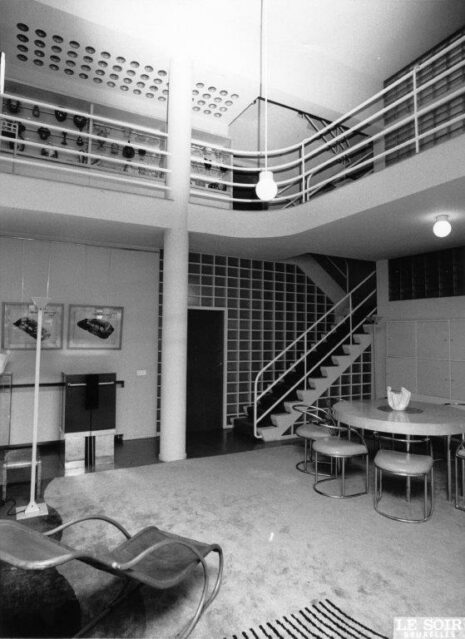 The double-height glazed living-room walls of the Maison Dotremont by Louis-Herman De Koninck (1932).
The double-height glazed living-room walls of the Maison Dotremont by Louis-Herman De Koninck (1932).
In these houses, the architects often follow the Five Points of modern architecture developed by Le Corbusier: free design of the plan, free design of the facade, horizontal windows, roof gardens, and pilotis. The Maison de Verre from 1936, was a prime example of such modernist architecture from the interwar period, applying most of Le Corbusier’s precepts. The layout was very flexible, with a double-height living room ending with a solarium terrace. In his design, Paul-Amaury Michel took advantage of new materials such as glass, which was used in different ways, transparent or not, depending on the room’s function and position. Just a stone’s throw from the Maison de Verre, Henry Van de Velde designed another version of modernism, the Hôtel Wolfers. Rather than various types and thicknesses of glass, this corner brick building displayed playful volumes and stepped terraces.
Reconstruction Period
Born in the interwar period, modernism came late to Brussels – but when it arrived, it affected the city significantly.[30] The Brussels 1958 Universal Exhibition clearly illustrated the will to take a modernist approach to reconstructing the country. Two developments left lasting marks on the city: new public infrastructures were built, mainly to accommodate automobile traffic; and two laws attempted to provide concrete solutions to the housing deficit brought about by the war. The law introduced by De Taye (1948) encouraged private initiatives, while Brunfaut’s act (1949) supported public housing activities through the financing of public space and infrastructure.
Additionally, two complementary regulations (De Taye 1953 and 1956) led to a massive clean-up and destruction of lower-class neighbourhoods (according to master plans known as Tekhné and Manhattan);[31] state subsidies were reserved for developments of at least 25 dwellings, prompting the production of large apartment buildings in the form of slabs and towers.
These two developments brought about large apartment blocks grafted onto a new infrastructural network. If the Résidence Palace is a symbol of the interwar period, the Martini Tower or Centre International Rogier by Jacques Cuisinier and Serge Lebrun, built in 1961 and demolished in 2001,[32] was probably its postwar counterpart. Built on the site of the former North Station, it is no longer a bourgeois palace but rather a multi-functional project that shelters a theatre, shops, a café, exhibition halls, offices, and housing. Its architect, Jacques Cuisinier, built a series of modernist landmarks in Brussels, such as the Brusilia Tower (1970) in Schaerbeek or La Magnanerie (1957 and 1961) in Forest.
After the Second World War, housing was resolutely collective, designed to generate solidarity among neighbours.[33] In terms of layout, plans were determined by functions. While Delhaye continued to be a reference, the National Housing Society (now SNL) also produced collections of standard plans.[34] Breaking with the tradition of standard row houses, housing projects reached new heights, despite sustained criticism from both the popular and specialist press.[35]
Two major approaches can be seen in post-war housing production. Public housing, on the one hand, tended to have a clearer affiliation with inter-war models such as the projects at Avenue Van Overbeke 243 (1961) and Peterbos 6 (1964). Two projects stood out in that regard. First, the well-named Cité Modèle in Laeken (1958), was designed to demonstrate Belgium’s position in terms of public housing.[36] Planned for the 1958 World Exhibition, it was an autonomous neighbourhood imagined as an “island of order and clarity”[37] taking a radical stand against “the chaos of the randomly drawn streets, filled, in Brussels, with particularly incoherent buildings.”[38] Its buildings included collective amenities such as shops, an auditorium, church, post office, etc., and rigorously followed the Five Points of modernist architecture. Willy Van Der Meeren’s Ieder Zijn Huis (1958), in Evere exemplified this attitude even better.[39] Free-standing on a grassy plain, the tall and slender building was oriented towards the north like a magnetised bar. It was raised on pilotis that initiated a repetitive portico structure spanning the entire width of the building. This simple and economical structure freed up façades made up of prefabricated concrete elements. Collective spaces were spread throughout the building, and included a meeting room, workshop, laundry, and even a morgue. Interior circulation was literally thought of as the extension of public space; from its two large entrance halls, large galleries every three levels designed as an extension of the public sidewalk, to a roof terrace accessible to all on the top floor. The function-free layout of the flats was shaped by cupboards and movable walls that made it possible to produce several types of housing. In these functionalist layouts, circulation was limited and each living space reduced to a minimum.
It was private developers, responsible for more than two-thirds of post-war production, who would have the greatest impact on the city with projects like La Magnanerie, Europa II (1962, Josse Franssen) or Brusilia (1970, Jacques Cuisinier). Generally speaking, these were less radical than public operations. Two private actors stood out during this period: Etrimo and Amelinckx. Founded in the 1930s by Jean-Florian Collin, Etrimo left its mark on housing with the production of 14,000 dwellings, but also on the Brussels subconscious with exceptionally homogeneous and easily recognisable buildings. Etrimo’s post-war production included three types of developments: “villa districts” such as the Chant d’Oiseau in Woluwé-St-Pierre or the Villas Parc Albert I (1960, Frans Draps/Etrimo), in Ganshoren; “bungalows” such as Domaine de l’Empereur in Uccle; or “apartment buildings in a park” such as Parc Aristide Briand in Woluwé-St-Lambert, Parc Jean Vivès in Anderlecht, Parc Beaulieu in Auderghem, Parc du Forum in Neder-over-Heembeek, and Résidence Parc Albert I (1964, Groupe Urbanisme – Etrimo), in Ganshoren among others. These large-scale operations were built on large landholdings (Château de Rivieren, Château Lambeau, etc.); former farms; or fallow land. In the absence of any legislation on heights or density, Etrimo set the tone by negotiating directly with municipalities and, in this respect, played a decisive role in the development of Brussels’ second belt. Those developments of the 1960s were located on the direct outskirts of the dense city back then, which has of course by now caught up with them. One of the main selling points was precisely the green surroundings and the accessibility of the city by car. Etrimo’s post-war production followed a repetitive logic. Buildings were generally limited to twelve storeys with an underground garage. Oriented along a north–south axis, they had balconies running along both long sides. Their painted pale-blue underside was a distinctive Etrimo feature. Inside, a basic layout of four dwellings around a vertical core was repeated two to four times depending on what the site allowed. Common services were provided for each building: rooftop drying rooms and a caretaker’s flat per core. Another of Etrimo’s influences was its resounding bankruptcy in 1970, which instigated the Breyne Act (1971) regulating real-estate sales on layaway, which is still in effect today.
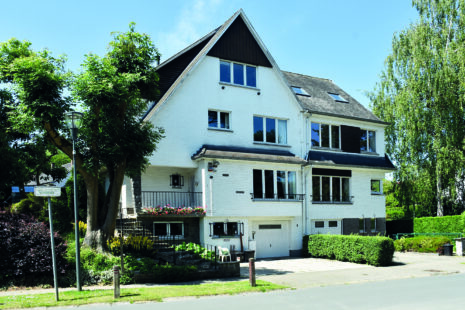 The Villas Parc Albert I from 1960 in Ganshoren by Frans Draps/Etrimo were one of the housing estates built by the private developer Etrimo.
The Villas Parc Albert I from 1960 in Ganshoren by Frans Draps/Etrimo were one of the housing estates built by the private developer Etrimo.
A great deal of post-war housing production was free-standing. Some, however, extend the interwar tradition of taller collective buildings on the boulevards and larger streets of the city; examples of this approach were the apartment buildings Churchill 126, 1949, Jean-Florian Collin (Etrimo) and De Roovere 14–16 (1957, Henri Van Damme). Additionally, individual private houses were still built during the period, for instance Maison Volckrick (1958, Georges Volckrick) and Maison Verhaegen (1960, Willy Van der Meeren, Léon Palm), perpetuating the city’s expansion based on closed city blocks.
These modernist buildings formed the fabric of Brussels’ 20th-century (second) belt, modifying the cityscape tremendously. If other housing forms challenged some of the four recurrent features of the Brussels referential type, modernism dismissed them all. Free-standing buildings rejected the structuring character of the closed urban block that provided front–back positions for each dwelling. The individual character of housing was also challenged as, for modernist architects, urban housing should be collective: “the regime of isolated habitations is obsolete”.[40] The limited height of traditional buildings was also criticised. In the interests of efficiency and the search for air and light, housing blocks soared towards the sky – thereby acquiring the status of monuments. Finally, the traditional layout of the bourgeois house was called into question. For modernist architects, circulation, room dimensions and location were determined by their purpose, deduced from ergonomic studies.
Post-Modernism
Architectural modernism marked the end of a cycle.[41] At the end of the 1960s, modernism was challenged as having a peremptory approach. From a social point of view, modernist buildings were rejected for their inability to create qualitative public spaces. Moreover, May ’68 marked the end of the centrality of the nuclear family around which modernist housing had been designed. From a technical point of view, too, modern materials such as Quarzolith, Glasal, or Colorbel began showing signs of decay. The earliest oil crises revealed that these buildings suffered from energy inefficiency and were expensive to build, just as they dealt a fatal blow to the general optimism born of economic growth.
Brussels at the end of the 1970s was marked by a rejection of the city and the departure in vast numbers of the middle and upper classes for the hinterland, leaving the city with the scars of modernist ambitions. Brussels was in the hands of developers who approached it as a place of business rather than a qualitative place to live. This phenomenon was called “Bruxellisation”. The remaining inhabitants protested against this demolition and the mercantile vision of the city, holding large demonstrations in the Marolles and the Northern District. These grassroots movements prompted the creation of associations such as l’Atelier de Recherche et d’Actions Urbaines (ARAU) and numerous inhabitants’ committees. Mandatory public urban-planning consultations would be one of their achievements.
Embracing the “right to the city”[42] and urban renewal, this movement developed a nostalgic and at times naive glorification of the past. This would in some cases lead to caricatures such as the neighbourhood of the Carrefour de l’Europe and the place d’Espagne around the Central Station, which is a pastiche of the traditional city with colonnades, gabled roofs and brick facades built in the 1980s. In terms of housing, a number of trends could be identified. Renovation became an alternative to demolition, as seen in the Rue aux Laines in front of the Palace of Justice, where demonstrations against the demolition of 26 houses led to their comprehensive renovation. Several new projects embraced the city’s traditional features such as the closed urban block and the street. The development at rue de Laeken 95–121 (1995, J. Altuna and M.-L. Petit; S. Assassin, B. Dumons, P. Gisclard, and N. Prat; V. Gevers, M. Heene, M. Leloup, and G. Somssich; J. Cenica-Celaya and I. Salona; M. Gaiani and G. Tagliaventi, J.-Ph. Garric, and V. Nègre; L. O’Connor – J. Robins (unit); Atlante), illustrated this tendency. Replacing a modernist office tower, the project featured a completely new urban block built on a parking garage.
Alternating individual houses and apartment blocks, the buildings literally replicated 19th-century European facades. Behind this veneer, however, could be found all the comforts of modernist housing. In Woluwe-St-Pierre, Les Venelles (1977, Groupe Ausia), produced a similar interpretation of pre-20th-century architecture. It framed a low-rise, close-like settlement where materials, volumes, and routes referred to an idealised image of European medieval cities. In both projects, there was an explicit quest for formal and typological variations to house a diversity of people and household configurations. Lucien Kroll pushed this awareness of user variety even further in La Mémé, a student housing project based on inhabitants’ participation at UCLouvain’s Woluwe-St-Lambert site. Kroll’s idea was to produce a flexible building where residents would be able to modify their dwellings as needed in fruitful cooperation with their neighbours. The facade of the building expressed this intention, displaying a kaleidoscope of different window frames and materials that contrasted with the stern and repetitive aspects of post-war buildings. Whether nostalgic for the traditional city or trying to invent new ways of living, post-modernism adopted several features of the referential type. Flexible design and even individual character, which had been set aside for economic reasons, were once again emphasised.
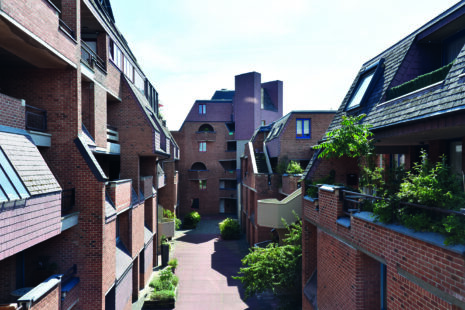 The low-rise apartment building Les Venelles (1977, Groupe Ausia) emulated the image of a medieval city.
The low-rise apartment building Les Venelles (1977, Groupe Ausia) emulated the image of a medieval city.
An Original Housing Genealogy
Comparison with the referential type allows us to chart a new genealogy of housing forms for Brussels. Based on spatial qualities rather than chronology, it provides an indication of why housing choices were made at various times: the reasons could be political, economic, societal, or technical. The alteration of the basement to accommodate garages with the arrival of cars and the disappearance of domestic servants; the recurring trend for living close to nature, whether individually in villas or collectively in garden cities; the possibilities introduced by the combined use of steel and glass, and their effect on housing layouts; the alternating housing policies sometimes advocating collectiveness, sometimes promoting individual homeownership; the influence of new technologies such as elevators, reinforced concrete, or prefabrication; the middle-class reluctance to live in apartments; the modification of household configurations and ways of living, etc., are all examples of these transformations. These changes generated new forms of living and produced an intense and diverse city.
This genealogy also sheds light on how particular ideologies such as modernism or classicism were embodied in a specific environment. While classicism affected housing only from a stylistic point of view without modifying its standard “DNA”, modernism brought radical change, dismissing all the traditional features of the Brussels standard housing type of terraced housing.
As new challenges arise in the 21st century, this spatial approach could be a key to envisioning future housing development for Brussels. Specific issues are examined in the article The Search for Quality Housing in Brussels: From 2000 Onwards.
Interestingly, even though it can serve as a yardstick against which to measure all the other forms of housing in Brussels, the referential type itself has evolved, for several reasons. First, although it still represents one third of the city’s housing stock, the traditional three-room-in-arow layout of the Brussels row house is forbidden today by the 1979 Building Regulations of the Agglomeration, which requires every newly built living space to have a direct opening to the outside.[43] Second, the garden, which was considered a leftover space in the 19th century, has gained interest, particularly in response to increased automobile traffic on the street side, modifying the hierarchy of the house by placing the most important living spaces at the back. Third, the standard type has in many cases lost its individual character. Its buildings are too spacious for smaller contemporary Brussels households and their evolving lifestyles.
Footnotes
Smets, Marcel. L’avènement de la cité-jardin en Belgique, Histoire de l’habitat social en Belgique de 1830 à 1930. Liège, Pierre Mardaga, 1977. Collection Architecture + Documents, pp. 34–35.
Dessouroux, Christian. Espaces partagés, espaces disputés. Bruxelles, une capitale et ses habitants. Brussels, Direction Etudes et Planification (AATL), 2008.
“The influence of housing on the morals, habits, health and well-being of populations is indisputable, and we might add that experience has made it an axiom. Wherever one finds a healthy, clean, tidy home, with a small garden, a few flowers, a few books, one can be sure in advance that the household that inhabits it is honest, thrifty, industrious and therefore relatively happy.” National Congress on Hygiene, 1852. In: Smets, Marcel. L’avènement de la cité-jardin en Belgique, Histoire de l’habitat social en Belgique de 1830 à 1930. Liège, Pierre Mardaga, 1977. Collection Architecture + Documents, pp. 192–194.
Ibid., pp. 46–58.
Cité des Grandes Rames in Verviers, 1808; Cité du Grand Hornu in Hornu, 1832; Cité de Bosquetville in Bois-du-Luc, 1836; Cité de l’Olivette Ste Catherine in Mariemont, 1854; etc.
Higginbotham, Peter. The Workhouse Encyclopedia. London, History Press, 2012; Posener, Julius. “Historique des HBM.” L’architecture d’aujourd’hui, no. 6, 1935, pp. 15–44.
Smets, Marcel. L’avènement de la cité-jardin en Belgique, Histoire de l’habitat social en Belgique de 1830 à 1930. Liège, Pierre Mardaga, 1977. Collection Architecture + Documents.
Brauman, Annick et al. Jean-Baptiste André Godin, 1817–1888: le familistère de Guise, ou, les équivalents de la richesse: the familistère at Guise, or, the Equivalents of Wealth. Brussels, Archives d’architecture moderne, 1980.
The first social-housing company, the Foyer Schaerbeekois, was founded in 1899.
Noël, Francoise. “Les politiques d’habitat.” Université Libre de Bruxelles, 2009, p. 7.
Van Dijk, Pauline. Immeubles à appartements de l’entre-deux-guerres. Brussels, Ministère de la Région de Bruxelles-Capitale, 2007. Bruxelles, Ville d’Art et d’Histoire, no. 43, p. 17.
Castermans, Auguste. Parallèle des maisons de Bruxelles et des principales villes de Belgique construites depuis 1870 jusqu’à nos jours. vol. 1, Liège, Noblet, 1852–1869, p. 84.
Paul Hankar did his internship in Henri Beyaert’s office, which might explain the influence of the Flemish Renaissance style in his work. Collectif. Bruxelles, construire et reconstruire: architecture et aménagement urbain, 1780–1914. Brussels, Crédit communal de Belgique, 1979.
Posener, Julius. “Le plan de l’habitation à bon marché.” L’architecture d’aujourd’hui, no. 7, 1935.
Hennaut, Eric and Liliane Liesens. Cités-jardins. 1920–1940. Brussels, AAM éditions, 1994; Schoonbrodt, René. Sociologie de l’habitat social. Gand, Editions des Archives d’Architecture Moderne, 1979; Smets, Marcel. L’avènement de la cité-jardin en Belgique, Histoire de l’habitat social en Belgique de 1830 à 1930. Liège, Pierre Mardaga, 1977. Collection Architecture + Documents; Van Dijk, Pauline. Immeubles à appartements de l’entre-deux-guerres. Brussels, Ministère de la Région de Bruxelles-Capitale, 2007. Bruxelles, Ville d’Art et d’Histoire, no. 43.
Brauman, Annick et al. L’immeuble et la parcelle. Les immeubles à appartements comme éléments constitutifs du tissu urbain. Le cas de Bruxelles. 1870–1980. Brussels, Archives d’Architecture Moderne, 1982, pp. 7–21.
Van Dijk, Pauline. Immeubles à appartements de l’entre-deux-guerres. Brussels, Ministère de la Région de Bruxelles-Capitale, 2007. Bruxelles, Ville d’Art et d’Histoire, no. 43.
Ibid., p. 27.
Delhaye, Jean. L’appartement d’aujourd’hui. Liège, Desoer, 1946.
Cloquet, Louis. Traité d’architecture. Eléments de l’architecture. Types d’édifices. Esthétique. Composition et pratique de l’architecture. vol. 4, Liege, Ch. Béranger, 1900.
Bauer, Catherine. Modern Housing. Cambridge, The Riverside Press, 1934; Giedion, Sigfried. Rationelle Bebauungsweisen: Ergebnisse des 3. Internationalen Kongresses für Neues Bauen, Brüssel, Nov. 1930. Stuttgart, Englert & Schlosser, 1931.
Steinmann, Martin. International Congress for Modern Architecture. CIAM: Dokumente 1928–1939. Basel, Birkhäuser, 1979.
Charlier, Sebastien. L’équerre: réédition intégrale – the complete edition. Liège, Éditions Fourre-Tout, 2012.
Beekaert, Geert and Francis Strauven. La construction en Belgique. 1945–1970. Anvers, Confédération nationale de la Construction, 1971; Vandenbreeden, Jos. Art Déco et Modernisme en Belgique. Brussels, Racine, 1996.
Strauven, Francis and Renaat Braem. René Braem: les aventures dialectiques d’un moderniste flamand. Brussels, Archives d’architecture moderne, 1985.
Vandenbreeden, Jos. Art Déco et Modernisme en Belgique. Brussels, Racine, 1996, p. 207.
Bourgeois, Victor. “Habitations Minima.” L’émulation, no. 11, 1931, pp. 391–414; Giedion, Sigfried. Rationelle Bebauungsweisen: Ergebnisse des 3. Internationalen Kongresses für Neues Bauen, Brüssel, Nov. 1930. Stuttgart, Englert & Schlosser, 1931.
Ledent, Gérald. “From Ideal Proposals to Serial Developments: Victor Bourgeois’s Schemes in the Light of Post-War Developments in Brussels.” Urban Planning, vol. 4, no. 3, 2019, pp. 196–211.
Mumford, Eric Paul. The CIAM Discourse on Urbanism, 1928–1960. Cambridge, Mass., MIT Press, 2002.
Demey, Thierry. Bruxelles, chronique d’une capitale en chantier, de l’Expo ’58, au siège de la C.E.E. Brussels, Paul Legrain/CFC éditions, 1992.
de Saulnier, Pierre. “Bruxelles à l’heure de la rénovation.” Habiter, 1963, pp. 2–34; Martens, Albert and Myriam Vanden Eende. Quartier Nord. Le relogement des expulsés. Brussels, EPO, 1994.
Built in 1961 by Jacques Cuisinier. Dejemeppe, Pierre. Bruxelles, les tours, la ville. Brussels, Région de Bruxelles-Capitale, 2010, pp. 53–56 and 120–121; Crop, Paul-Alexander. “Residentiële hoogbouw in Brussel van architect Jacques Cuisinier.” Faculteit Letteren en Wijsbegeerte, Vrije Universiteit Brussel, 2007.
Jasinski, Stanislas. “A propos des immeubles à logement collectif.” La Maison, no. 6, 1957.
Mombach, Marcel. Plans minima. Première série. 1948–1949. Brussels, Société Nationale des habitations et logement à bon marché, 1948.
Van Dijk, Pauline. Immeubles à appartements de l’entre-deux-guerres. Brussels, Ministère de la Région de Bruxelles-Capitale, 2007. Bruxelles, Ville d’Art et d’Histoire, no. 43, p. 30; Marique, Robert. “Buildings ou tours à taudis.” La Maison, vol. 7, 1947, pp. 172–197.
Bernard, Pierre et al. La cité modèle à Bruxelles. Vie(s) d’un grand projet. Brussels, Aparté, 2012.
Strauven, Francis and Renaat Braem. René Braem: les aventures dialectiques d’un moderniste flamand. Bruxelles, Archives d’architecture moderne, 1985, p. 75.
Ibid., p. 75.
De Kooning, Mil. Willy Van Der Meeren: Ieder Zijn Huis, passé et futur d’une unité d’habitation à Evere. Brussels, CIVA, 2012; Ledent, Gérald. “Habiter toutes les dimensions. Un regard sur le bâtiment Ieder Zijn Huis de Willy Van der Meeren.” Willy Van Der Meeren: Ieder Zijn Huis, passé et futur d’une unité d’habitation à Evere, edited by CIVA, Brussels, CIVA, 2012, pp. 51–57.
Bourgeois, Victor. “Habitations Minima.” L’émulation, no. 11, 1931, p. 402.
Several authors such as Manfredo Tafuri, Charles Jencks, and Reyner Banham claim that the late 1960s coincided with the end of modern bourgeois ideologies and the “death” of modernist architecture, opening up a new cycle. Banham, Reyner and Francois Dallegret. “A home is not a house.” Art in America, vol. 2, 1965, pp. 70–79 ; Jencks, Charles. The Language of Post-modern Architecture. New York, Rizzoli, 1977; Tafuri, Manfredo. Architecture and Utopia: Design and Capitalist Development. Cambridge, Mass., MIT Press, 1976.
The “right to the city” is a concept proposed by Henri Lefebvre, understood as a call to the citizens to reclaim the city. Lefebvre, Henri. Le droit à la ville. 3 ed., Paris, Anthropos, 1968.
Eloy, Marc et al. Influence de la législation sur les façades bruxelloises. Brussels, C.A.R.A./C.F.C., 1985.
Internal Links
Originally published in: Gérald Ledent, Alessandro Porotto, Brussels Housing. Atlas of Residential Building Types, Birkhäuser, 2023. Edited for Building Types Online.